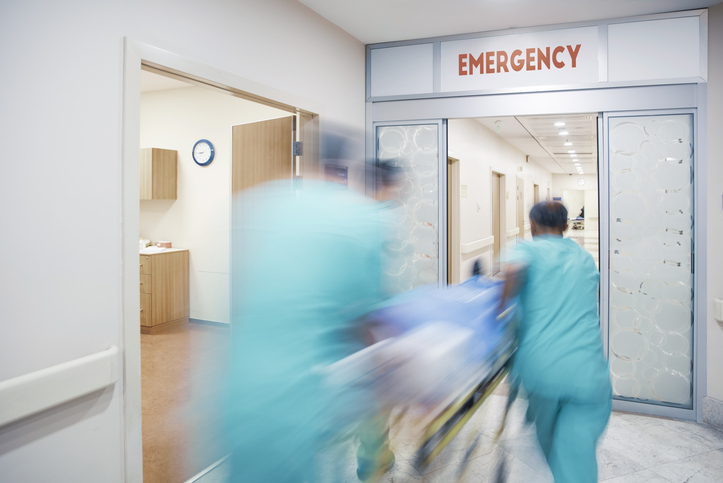Elevating Community Care as a Level II Trauma Center
October 14, 2025
Tags: Emergency Medicine, Emergency Care
Riverside Healthcare has long been a pillar of compassionate care in the community, and as a designated level II trauma center, it has taken its commitment to patient health and safety to new heights. Recognizing the critical role trauma care plays in saving lives, Riverside has invested in cutting-edge technology, expert medical teams, and advanced training programs to provide the highest level of emergency and trauma services.
This article explores how Riverside’s trauma center meets the diverse needs of the community, offering not only life-saving care but also a compassionate approach that emphasizes healing and support for patients and their families during some of life’s most challenging moments. We turn to the expertise of Cris Langellier, Director of Emergency Services and Dana Arseneau, Trauma Program Coordinator.
What Constitutes a Level II Trauma Center?
A level II trauma center is designated based on specific criteria set by the American College of Surgeons (ACS) and other regulatory bodies. The parameters for this designation generally include:
24/7 Availability of Key Medical Personnel: A level II trauma Center must have trauma surgeons available at all times, often with the ability to perform emergency surgeries. The center must also have critical care physicians, anesthesiologists, radiologists, and other specialists available around the clock.
Advanced Diagnostic and Treatment Capabilities: The center must have advanced imaging capabilities, such as CT scanners and X-ray, available 24/7. It should be equipped with the necessary technology and facilities to manage a wide range of trauma cases.
Comprehensive Trauma Care: A level II center must be able to provide comprehensive care, including trauma resuscitation, immediate surgical intervention, and specialized treatment. It must be capable of treating both adult and pediatric patients and should have specialized programs for the most complex trauma cases.
Collaborations and Transfer Agreements: As a level II center, the hospital is required to have strong relationships with higher-level centers (level I) for cases that may need additional resources. It should have transfer protocols in place to send critically injured patients to level I centers if necessary.
Trauma Education and Research: The center must engage in trauma education for healthcare providers and the community, ensuring that medical staff are continuously trained in trauma care. Research and data collection on trauma treatment outcomes are often part of a level II center’s responsibilities.
Community Outreach: A level II center is expected to be involved in injury prevention programs and education for the community to reduce trauma-related incidents.
“It really is what is right for the community. The trauma designation reinforces our commitment to providing the best possible care to our patients,” states Langellier. “We want to keep these patients in our community as opposed to transferring them somewhere else. Being a trauma center gives us that capability.”
In order to truly achieve positive outcomes, collaboration between different medical teams is essential. “We all work together. There are a lot of data points we have to manage as a team. We meet consistently every month, the whole group of us. The surgeons are very involved and they show up,” notes Arseneau. “The goal is to provide specific, top-level care. So, we are constantly assessing metrics and analyzing what we can do to improve as a team.”
Investments in Technology, Equipment, and Education
Riverside has continually updated its trauma center with advanced equipment to provide top-tier care. In addition to this, the center runs strong community prevention programs, like the Distracted Driving Program, which educates high school students on the dangers of phone use while driving.
The program, led by Arseneau, has shown promising results, with data indicating that students who participated in the program have fewer car crashes. This initiative builds on past programs like the "Don't Drink and Drive" campaign.
“All the teens who came into the hospital last year had not been through Dana’s program. This year, out of the teens who have come in involved in trauma, three had been through her program but they were not drivers. They were in the passenger seat and they were seat-belted, so they were listening,” shares Langellier. “It proves to me it's an effective program that we really want to keep going.”
When You Need Trauma Care, Riverside Is There
Arseneau emphasizes the importance of community members being aware of the local level II trauma center designation for severe and life-threatening injuries. People should choose it for care in cases of serious trauma, such as car accidents, electric bike or scooter injuries, gunshot wounds, stab wounds, major falls, traumatic brain injuries, or spinal cord injuries—as the center offers specialized services for these types of injuries.
“We are here and equipped to address those life-changing, out-of-the-blue, unfortunate accidents. You definitely want to go to a trauma center so you have the best possibility of surviving,” she urges. “There is a rule in trauma called the golden hour, and if you sit back for that first hour, the risk of death goes up dramatically if you're not at the right place.”
For more information about emergency care at Riverside visit myrhc.net/emergency.